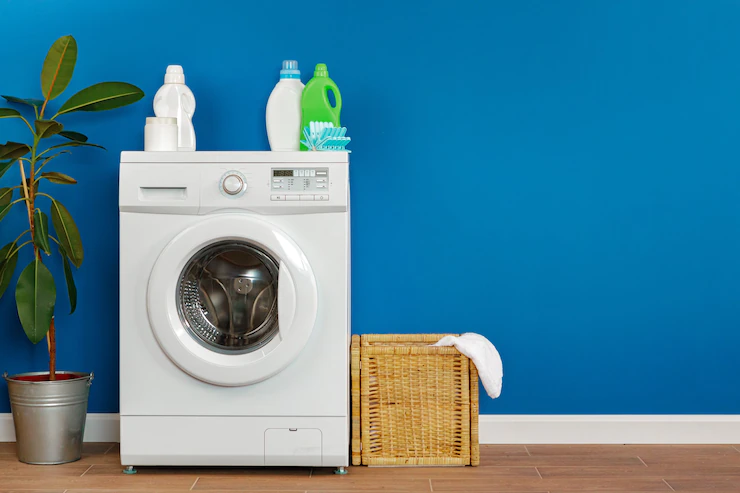cleaning washing machine drains
Washing machines can have problems, such as clogging or slow draining. When your washing machine doesn’t drain well, it’s often because of soap residue, lint, and grease and oils that come out of your clothes. To fix this problem, you need to clean the drain pipe. This is usually done with a chemical or manually with an auger tool. With a little time and effort, you can fix your washing machine drain so that it flows freely again.

Using drain cleaners
1. Find the washing machine drain
Usually, the drain of the washing machine goes through the pipe at the back of the machine and the hose connected to it into the sewer pipe. Sometimes the hose is firmly attached to the drain pipe, or the hose may simply slide into it.
- When identifying the drain, you must distinguish it from the hot and cold water lines that enter the washer. Hot and cold water lines should be smaller than the drain pipe and may be marked with red and blue colors to indicate which is hot and which is cold.
2. Pour hot water into the drain of the washing machine.
If your washing machine drains slowly but isn’t completely clogged, you can simply run very hot water down the drain tube to clear it. This can loosen soap and scum that clogs your drain.
- If you run your washing machine with hot water most of the time, it may not be working for your drain problem because you have done it so many times. However, if you only run cold cycles, running hot water down the drain may be worth a try.
- In areas that freeze during the winter, drain pipes can freeze and become blocked with ice. If your area is frozen and you think your drain is blocked, try running hot water down the drain to get rid of the ice.

3. Buy a commercial drain cleaner.
If your washing machine drain is clogged, one way to clear it is to use a commercial drain cleaner. In general, these products can be very helpful for minor clogs, but they have limitations when it comes to unclogging completely clogged pipes.
- When purchasing a commercial drain cleaner, make sure it is safe for use with the specific type of pipes and type of drainage system you have. Some strong products that contain sulfuric acid can actually damage PVC pipes and are generally not good for the environment either.
4. Disconnect the washing machine drain.
To use a commercial drain cleaner, you must disconnect the drain line from the appliance and pour the cleaner directly into the drain. On some machines, you can simply pull the tube that comes out of the machine out of the drain tube. However, in some cases, you need to open the drain tube from the bottom of the back of the device.
- If you do this, wait for some water to come out of the machine and run the hose down the drain.
5. Follow the instructions on the package.
This usually starts with pouring the product down the drain with some very hot water. Then you have to wait a certain amount of time for the product to do its job. Finally, when the product has had time to clear, you should flush the drain.
- Make sure to flush the drain cleaner after the specified period of time. Leaving it on too much can damage the pipes.

Snake draining a drain
1. Disconnect the drain hose from the device
If the hose you are trying to remove from the machine is clogged with chemicals, you will need to use a snake drain to get rid of it. This requires you to disconnect the hose from the machine so you can lower the snake drain.
- There should be a clip connecting the two that you can use a screwdriver to pry apart. Remember that when you disconnect the hose, some water will probably come out of the machine and the hose. So be sure to put a bucket and some towels nearby. This is especially true if the drain is so blocked that there is stagnant water in the machine.
2. Place a drain snake in the drain of the washing machine.
Once you free the drain tube, you can insert the snake drain into it. A snake drain is a tool that consists of a long, strong wire that goes down the pipe and a handle at the end that turns it. The key is to push the snake drain into the pipe. When you feel resistance, you should turn the handle clockwise on the snake drain to remove any clogged debris.
- There are different lengths of snake discharge to choose from. Medium-length drain snakes, about 15 to 23 meters long, usually work well for homeowners dealing with all types of clogs because they can clear most of the pipe clogs and are easier to work with than snake drains. It is taller and bigger.

Drain the drain until all resistance is gone.
It may take some time for the snake drain to rotate until the clogged area connects to the snake drain. When you have cycled it several times, pull out the snake drain and clean out all the debris. Then reinsert the snake drain to remove any excess debris. You may also want to push the snake drain further down the drain after clearing an area to make sure there are no other clogs.
- As you turn the handle, you may want to pipe the snake drain in and out a bit. This will help the drain snake to stick to any debris in the pipe and release it. When you think the drain is empty, pull the drain snake out of the pipe. To check if the clog is still there, you can run water into the washing machine before plugging it back in.
Reconnect the hose.
When you are sure that there is no blockage, you should reconnect the hose to the device. Be sure to attach the drain hose securely to the machine, as this is the point where the washing machine tends to leak. Run the washing machine without clothes and drain the water inside to make sure you have fixed the drainage problem. You should also look at the connection point between the device and the drain hose for any leaks.

Note
In order to minimize the possibility of washing machine drain clogging, place a wire lint trap at the end of the drain pipe that exits your machine. This will catch lint and debris from the washing machine and limit the chance of it clogging up your drain. However, you should wash this lint trap regularly so that the water can be easily removed from your washing machine.
______________________________________________________________________________________________________________________________________________________________________
To view more articles and follow us on different social networks a Instagram, Telegram, Apparatus and LinkedIn . Write your opinion about this article in the comment section.
______________________________________________________________________________________________________________________________________________________________________
 Lopez home appliance store | Selling Lopez household appliances is simply everything
Lopez home appliance store | Selling Lopez household appliances is simply everything 







